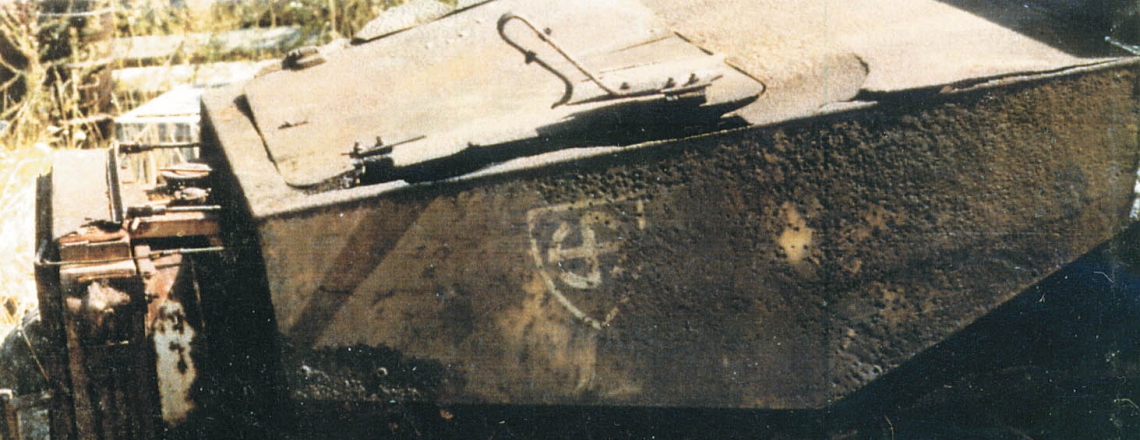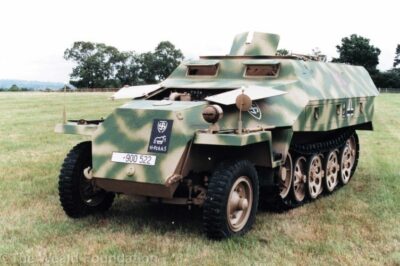Graz, April 1945. Facing the prospect of certain defeat by advancing Russian troops the Foundation’s Sd.Kfz.251 Ausf.D was abandoned by remnants of the 5th SS Panzer Division Wiking. This division was made up almost entirely of non-German volunteers drawn from across Europe. Nearly 30 years later in 1974 our Sd.Kfz.251 was discovered by a group of enthusiasts in a huge local scrap yard.
The Sd.Kfz.251 was discovered during the extensive clear up of Austria after the Russian occupation ended in 1955. The vehicle was dumped in a local scrap yard used for war materiel. The Sd.Kfz.251 was discovered along with two Sd.Kfz.250 Ausf. Bs. The vehicles were all in extremely poor condition, with the Sd.Kfz.251 in the worst shape. Much of the body had been crushed under the weight of the scrap metal above. A benefit of its position at the bottom of the scrap heap, meant that oil from the parts and vehicles above kept large sections of the body rust free. This not only helped preserve the paintwork but best of all, the unit and tactical insignia.
The Foundation came across this vehicle by chance during a trip to Austria in 1999. We were looking for Sd.Kfz.251 parts, together with parts for other vehicles for our ongoing restoration programme. We were offered an SS Wiking 251. Initially we turned it down but eventually agreed to take a look at the vehicle.
It had been poorly restored, painted over for film work and then left outside for over 10 years. All of the armour repaired by the previous owner would have to be re-welded. Interestingly the Sd.Kfz.251 had been fitted with a Maybach HL42 dry sump engine and some of the camouflage patten remained. Additionally, the lettering on the sides had been traced at the time of recovery by the original owner; as was the unit insignia, together with their respective colourings.
We decided that we had to have the Sd.Kfz.251.
Once the vehicle had been shipped to the UK, it was unloaded and her true condition was assessed. To help with our investigation, the Aufbau (body) was removed from the chassis. The chassis had suffered over time with the thinner, non-armoured components badly corroded and in need of replacement. All the critical cross member strengthening tubes in the chassis were in a poor state due to prolonged exposure to the elements. The chassis frame was in a slightly better condition but would require a lot more work.
Some of the sections that had been grafted in to the Aufbau of the half track were made of mild steel. We opted instead for sections of original armour which during the late 1990s - early 2000s were available in abundant quantities from various scrap dealers. We then sought advice from a contractor working with the Ministry of Defence on armoured vehicles regarding how best to deal with the welding of the shattered Aufbau.
A collector friend supplied the skin sheets for the inside of both the cabin and the personnel seating area, he also supplied some key instrumentation and a number of other components.
We had decided to set a project completion date, so that we could attend the War and Peace Show held each year in Kent with the the Sd.Kfz. 251. A long-standing French friend of ours agreed to come over and assist in the project. We also arranged for a local engineering company, who were delighted to help with a project of this kind.
A wet sump engine that we had previously restored, was installed together with all of the winter heating mechanism. This replaced the dry sump HL42 for which we at this time, could find no evidence that it had been installed in the first place. The original radiator shroud was brought back into service with a freshly produced core.
The wheels and tracks were stripped from the Fahrgestell (chassis). The tracks had to be individually disassembled. The bearings and the perished rubber seals had to be replaced. The track undersides or shoes had in many cases worn through due to excessive use back in 1944. This wear required the cutting of profiled plate sections to be welded over the original worn areas. The result was a new set of links which were reassembled using a combination of new and old track pins.
The camouflage did not pose much of a challenge given the number of original photographs of SS-Wiking Sd.Kfz.251s in late 1944 in the various publications including Panzergrenadiere der Panzerdivision 'Wiking' im BILD - published by Nation Europa Verlag GmbH.
We were not fortunate enough to recover the Fahrgestellnummer (chassis number). However our skills in unearthing the various numbers has improved significantly since, so we intend to return to the quest at some point in the future.
- This article has 798 words
- Reading time: 3 minutes
- There are no photos
Become a Member - Access the Full Article
Members gain access to the full content of our articles, including photo galleries.


